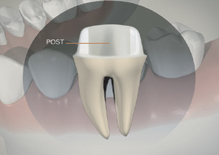| How | Filling | Extraction | Crown | Root Canal |
How

Plaque forms on your teeth every day. The sugar in the food that you eat reacts with the plaque and produces acid. Without proper brushing and flossing, the acid wears down the tooth’s enamel causing teeth to decay. Areas that are prone to tooth decay are along the gumline, the crevasses of the chewing surfaces of your teeth, and between your teeth.
When tooth decay damages a cusp, a crown restoration is required. To begin the restoration, the damaged tooth is first prepared by removing any decay or old filling. New filling is then placed to support the crown restoration. Your dentist will then take impressions in order to model the exact shape required for the crown. A temporary crown is made and inserted until the final crown is ready.

Filling

When a tooth is slightly decayed, a filling can be used to restore the tooth. In this example, you can see that the decay is through the tooth’s enamel, but not all the way to the pulp chamber. It is important to receive timely dental attention to prevent the decay from spreading further inside the tooth.


Extraction




Crown

 Meanwhile, the impression is sent to a dental lab where the final restoration is made. To create the restoration, an accurate model is first made from the impression. The model is then placed on an instrument that simulates jaw movement to ensure the restoration will function properly. Wax is formed into the shape of the tooth to create a mould, which is then filled with the restoration material. This is called the casting procedure. The crown is then trimmed and polished so that it will fit perfectly in your mouth.
Meanwhile, the impression is sent to a dental lab where the final restoration is made. To create the restoration, an accurate model is first made from the impression. The model is then placed on an instrument that simulates jaw movement to ensure the restoration will function properly. Wax is formed into the shape of the tooth to create a mould, which is then filled with the restoration material. This is called the casting procedure. The crown is then trimmed and polished so that it will fit perfectly in your mouth.
 When the final crown is ready, the temporary crown is removed, and the final crown restoration is cemented in place. Your dentist or hygienist will be able to answer any other questions you have about the procedure.
When the final crown is ready, the temporary crown is removed, and the final crown restoration is cemented in place. Your dentist or hygienist will be able to answer any other questions you have about the procedure.
Root Canal

 |
 |
 |
 |
 |


